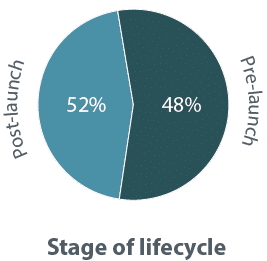This article explains what in-life product management is and how it fits within the Product Management Lifecycle.
You can read all the articles in our Product Management Journal – In-life by signing up for free here.
The high-level process that any product-based business goes through is the same. It can be summarized in the figure below.

As a company, we’re looking for opportunities (new product ideas) that can make us money. Once we’ve chosen one, we have to get it to market by either building the product ourselves, buying it from someone else, or partnering with another company.
Then we launch it and start selling it. However, it’s very unusual only to sell the first version. Typically, we do some more planning, see what additional features customers want, and refine the product to produce another, better version. And we do this again and again.
Finally, at some point, we decide there is no more money to be made, so we exit the market and close down the product.
The period up to launch is known as New Product Development (NPD), and the time after launch is known as In-life Product Management.
The Product Management Lifecycle model

We can look at this in more depth with our Product Management Lifecycle model (see above). This shows what’s involved for any company that develops and sells products. It applies at a product, release, or feature level. You can see our Product Management Lifecycle infographic here.
The major stages (the arrows) involve different teams and people from across the business. Product management is typically involved in each stage – whether it’s prioritizing requirements, writing business cases, checking what’s been built, or managing a launch.
If we focus on the In-life stage, the key activities are selling the product, tracking performance, and fixing issues. But, we’re also usually thinking about developing the next version of the product.
In a B2B market with a small number of big customers, product managers often get directly involved in the selling process. They attend sales calls to present the roadmap and explain the product proposition. In markets with larger numbers of customers, that’s not possible (it would take too much time) so, more of the focus is on helping Marketing with sales support material for the different sales channels to use or training the sales teams.
Tracking performance is a key part of in-life product management. You need to measure different aspects of your product to be able to spot problems and know how you’re doing. Our article ‘Measure what matters’ later in this Journal covers this in-depth.
It’s also important to track what’s going on in the market. What are competitors up to? What are our customers saying? Are there major industry trends that will affect us? As product managers, we need to understand how the market is shifting so we can update the product proposition and create a roadmap to ensure future success.
Fixing issues
Finally, any product will have issues – things that aren’t working properly. These can range from a feature bug to problems with the pricing model or an issue with the customer experience. These things usually arrive without warning, and the product manager is asked to sort them out. This work is often known as trouble-shooting or firefighting.
From our 2018 Product Management Survey, we know that the average product manager spends over half their time on unplanned work. Some of this may be related to NPD, but much of it relates to in-life products and customers – which means there is pressure to sort issues quickly.
Post-launch and pre-launch work
We can also see from our 2019 survey that the average product manager spends 48% of their time on pre-launch activities. That’s because, even if a product manager has a product that has already launched, much of the work they do is still considered to be NPD. That is pre-launch work for future versions of the product.
Conclusion
Our experience is that the bulk of in-life work involves fixing issues. And, because these often impact customers, they are seen as urgent. Other teams are sometimes happy to escalate any issue with the product through to product management, even if they could take ownership of the problem. The volume and unpredictability of this work can mean product managers struggle to find time to do other important in-life activities such as getting insights into the market. In addition, many companies have poor product reporting so product managers find it difficult to know how their product is doing.
In-life product management can be very challenging!




